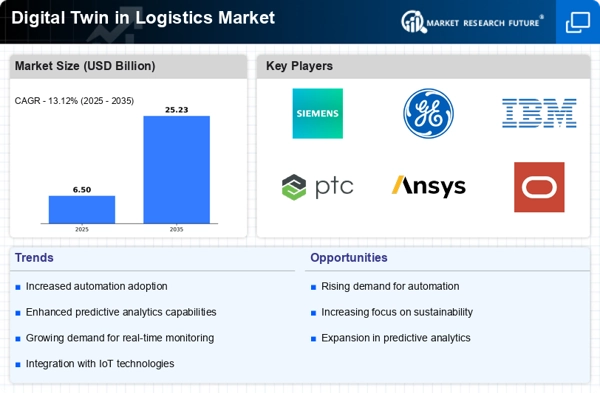The Digital Twin in Logistics Market is currently characterized by a dynamic competitive landscape, driven by the increasing demand for operational efficiency and real-time data analytics. Major players such as Siemens (DE), General Electric (US), and IBM (US) are at the forefront, leveraging their technological prowess to enhance supply chain visibility and optimize logistics operations. Siemens (DE) focuses on integrating advanced digital twin technologies with IoT solutions, aiming to create a seamless connection between physical and digital assets. Meanwhile, General Electric (US) emphasizes its commitment to sustainability, utilizing digital twins to improve energy efficiency in logistics processes. IBM (US) is strategically positioned through its AI-driven analytics, which enhances predictive maintenance and operational decision-making, thereby shaping a competitive environment that prioritizes innovation and technological advancement.
The market structure appears moderately fragmented, with key players employing various business tactics to gain a competitive edge. Localizing manufacturing and optimizing supply chains are prevalent strategies among these companies, allowing them to respond swiftly to market demands. The collective influence of these major players fosters a competitive atmosphere where collaboration and technological integration are paramount, ultimately driving the market towards greater efficiency and effectiveness.
In August 2025, Siemens (DE) announced a strategic partnership with a leading logistics provider to develop a comprehensive digital twin platform aimed at enhancing supply chain transparency. This collaboration is expected to facilitate real-time monitoring and predictive analytics, thereby improving operational efficiency. The strategic importance of this partnership lies in its potential to set new industry standards for digital twin applications in logistics, positioning Siemens as a leader in this evolving market.
In September 2025, General Electric (US) unveiled its latest digital twin solution designed specifically for the logistics sector, which incorporates advanced machine learning algorithms to optimize route planning and inventory management. This innovation is significant as it not only enhances operational efficiency but also aligns with the growing emphasis on sustainability within the logistics industry. By reducing carbon footprints through optimized logistics operations, General Electric is likely to strengthen its market position while addressing environmental concerns.
In October 2025, IBM (US) launched a new AI-driven digital twin application that integrates seamlessly with existing logistics management systems. This application aims to provide real-time insights into supply chain performance, enabling companies to make data-driven decisions swiftly. The strategic importance of this launch is underscored by the increasing reliance on AI technologies in logistics, suggesting that IBM is well-positioned to capitalize on this trend and enhance its competitive differentiation.
As of October 2025, the competitive trends in the Digital Twin in Logistics Market are increasingly defined by digitalization, sustainability, and the integration of AI technologies. Strategic alliances among key players are shaping the landscape, fostering innovation and collaboration. Looking ahead, it is anticipated that competitive differentiation will evolve from traditional price-based competition to a focus on technological innovation, supply chain reliability, and sustainability initiatives. This shift underscores the necessity for companies to adapt and innovate continuously to maintain a competitive edge in this rapidly changing market.

















Leave a Comment